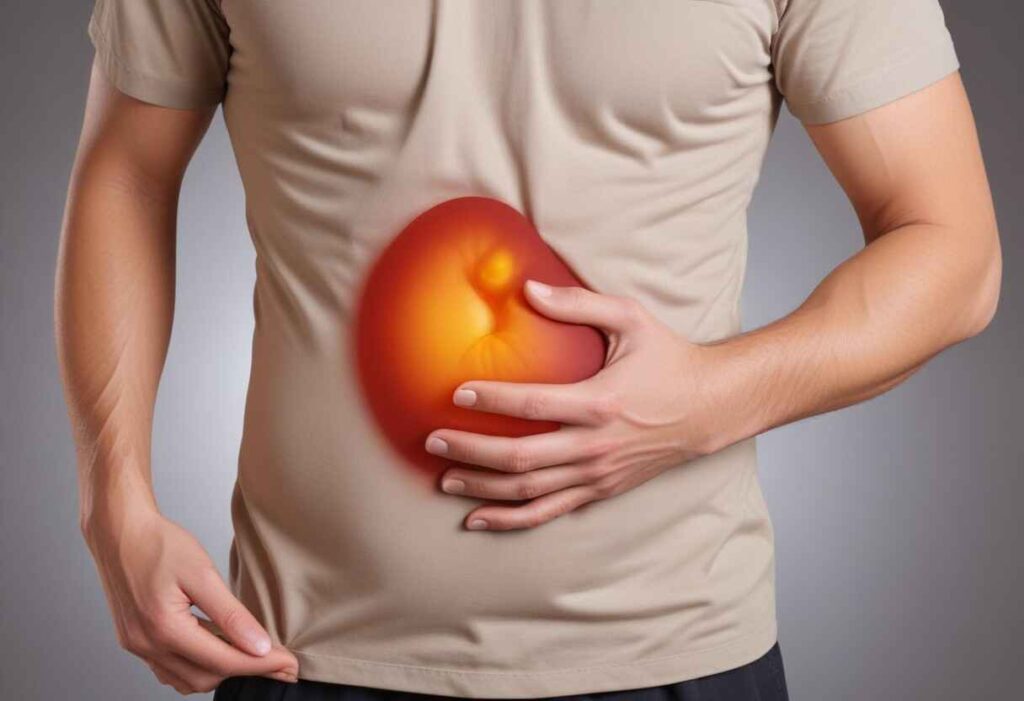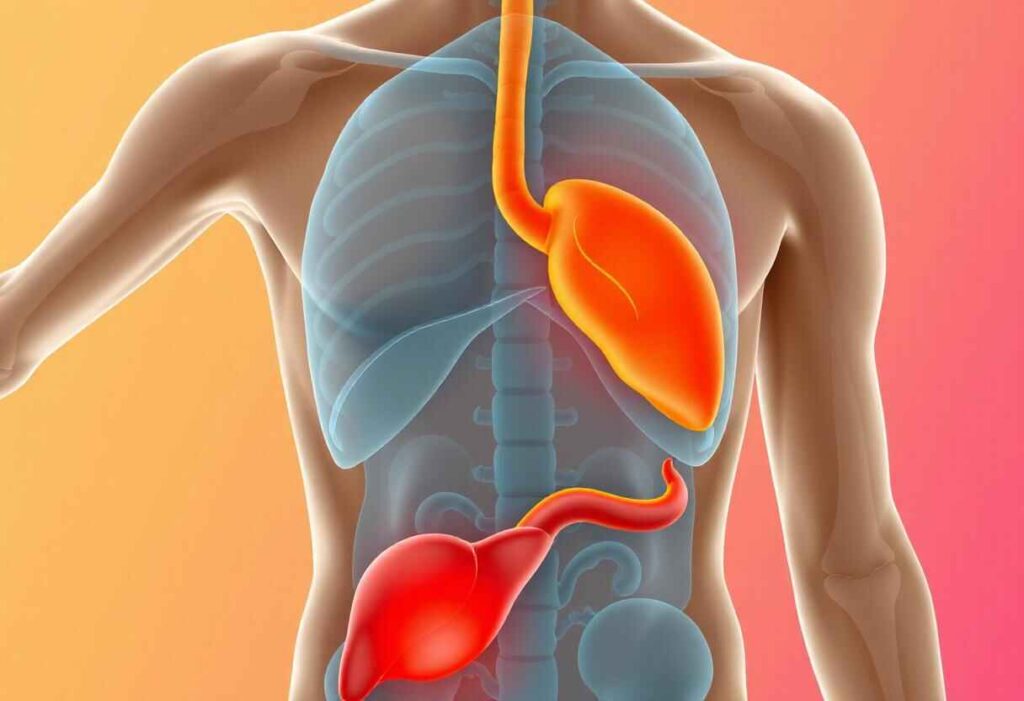Gallstones are hard lumps that form in the gallbladder, a small organ under the liver. They can cause a lot of pain and discomfort when they block the flow of bile. Knowing what gallstone pain feels like is important so you can recognize the problem early and get medical help.
Understanding Gallstone Pain
Gallstone pain, known as biliary colic, usually happens in the upper right side of the abdomen. This pain can be sharp and intense or start as a dull ache that gets worse over time. Here’s what you might feel:
Where You Feel It:
- The pain starts in the upper right part of your belly, just below the ribs.
- It can spread to your back, between your shoulder blades, or even to your right shoulder because the nerves in these areas are connected.
What the Pain Feels Like:
- The pain is often a constant, steady ache rather than waves or cramps.
- It might feel like a severe muscle spasm or like being stabbed.

How Long It Lasts:
- A gallstone pain episode can last from a few minutes to several hours.
- If a stone completely blocks the bile duct, the pain can last until the blockage is cleared.
What Triggers the Pain:
- The pain often starts suddenly, especially after eating a fatty meal. Fatty foods make the gallbladder contract, which can push a stone into the bile duct.
- The pain might also occur at night, waking you up.
Other Symptoms:
- You might feel nauseous and vomit.
- There could be bloating or a general discomfort in the belly.
- Some people might have a fever or chills, especially if there’s an infection due to the blockage.
How Bad It Can Be:
- The intensity of gallstone pain varies. For some, it’s a mild discomfort, but for others, it can be so severe that they need immediate medical help.
- Sometimes, the pain can be mistaken for a heart attack, especially if it spreads to the chest and back.
| Related: Upper Right Abdominal Pain After Gallbladder Removal |
How Gallstone Pain is Different from Other Pains
Gallstone pain can be confused with other types of abdominal pain, like those from indigestion, pancreatitis, or kidney stones. Here’s how to differentiate between them:
Gallstones vs. Indigestion:
- Indigestion: Causes a burning feeling or discomfort in the upper abdomen, often with burping or bloating.
- Gallstone Pain: More severe and lasts longer than indigestion.
Gallstones vs. Kidney Stones:
- Kidney Stone Pain: Usually felt in the lower back or side, and can spread to the groin. It is typically sharp and cramping, and comes in waves.
- Gallstone Pain: Located in the upper right abdomen and does not come in waves.
Gallstones vs. Pancreatitis:
- Pancreatitis Pain: Very severe, in the upper abdomen, and radiates directly to the back. Often comes with a rapid pulse and fever.
- Gallstone Pain: Also severe and in the upper abdomen but tends to spread to the shoulder or back and isn’t usually linked to a rapid pulse.
| Type of Pain | Description of Pain | Location | Duration | Key Differentiators |
| Gallstone Pain | Sharp, cramping, or steady ache, often intense. | Upper right abdomen: May radiate to the back or right shoulder. | 30 minutes to several hours: Often occurs after fatty meals. | Triggered by Eating: Especially fatty or oily foods. |
| Heart Attack Pain | Pressure, squeezing, or a burning sensation; may feel like indigestion. | Center of the chest: May radiate to the left arm, jaw, or back. | Minutes to hours: Can be sudden or gradually worsen. | Accompanied by Other Symptoms: Shortness of breath, sweating, nausea. |
| Peptic Ulcer Pain | Burning or gnawing pain, often relieved by eating or antacids. | Upper middle abdomen: Near the sternum. | Hours to days: Often follows a pattern, related to meals. | Timing with Meals: Pain often occurs a few hours after eating. |
| Kidney Stone Pain | Severe, sharp, cramping pain, often described as colicky. | Lower back or flank: May radiate to the lower abdomen and groin. | Minutes to hours: Pain may come in waves and vary in intensity. | Accompanied by Urinary Symptoms: Blood in urine, frequent urination, or burning sensation. |
Characteristics of Gallstone Pain
Gallstone pain usually feels like a specific type of discomfort in the abdomen. Here are some common traits:
- Location: Usually felt in the upper right part of the abdomen, but can spread to the back or right shoulder blade due to shared nerve pathways.
- Duration: Lasts from a few minutes to several hours. Pain may come back off and on, especially after eating fatty or oily foods.
- Severity: The intensity varies. Some feel mild discomfort, while others describe it as very intense.
- Triggers: Eating fatty or fried foods can trigger the pain. Also, large meals or eating late at night can make symptoms worse.
| Characteristic | Description | Location | Duration | Triggers |
| Nature of Pain | Often described as sharp, cramping, or a steady ache. | Upper Right Abdomen: Pain may also radiate to the back or right shoulder. | 30 minutes to several hours: Pain typically subsides on its own but can last longer in some cases. | Fatty Meals: Pain often occurs after eating a high-fat meal. |
| Intensity | Can range from mild discomfort to severe, intense pain. | Epigastric Region: Pain can also be felt in the upper middle abdomen. | Intermittent or Constant: Pain may come and go or persist for a prolonged period. | Nighttime: Symptoms can occur at night, waking the person from sleep. |
| Associated Symptoms | May include nausea, vomiting, bloating, and belching. | Right Shoulder Blade: Pain might radiate to the shoulder or back. | Rapid Onset: Pain can begin suddenly and escalate quickly. | After Eating: Symptoms often start within an hour after eating. |
| Alleviating Factors | Pain may improve with rest or lying still, though relief is often temporary. | Upper Back: Pain can spread to the upper back between the shoulder blades. | Recurring: Pain may occur in episodes, especially after fatty meals. | Certain Foods: Spicy or oily foods can also trigger symptoms. |
Feelings Associated with Gallstone Pain
Gallstone pain can show up differently for everyone. Here are some common feelings linked to it:
- Sharp or Sudden Pain: Often starts suddenly and intensely, usually in the upper right abdomen, below the ribs.
- Steady Ache: Sometimes feels more like a constant ache, like a gnawing discomfort that lasts for hours.
- Radiating Pain: Can spread from the upper abdomen to the right shoulder blade, back, or even to the chest.
- Pain after Eating: Eating fatty or oily foods can trigger or worsen the pain, sometimes right after eating them.
- Nausea and Vomiting: Some people with gallstones may feel sick and throw up along with the pain.
- Tenderness: The area around the gallbladder might feel sore to the touch.
Conclusion
Gallstone pain is a strong, often severe discomfort that begins in the upper right abdomen and can spread to your back and shoulders. Recognizing this pain and knowing its signs can help you get medical care quickly and avoid problems. If you feel this kind of pain, especially after eating a fatty meal, don’t ignore it. See a doctor to find out what to do next.


